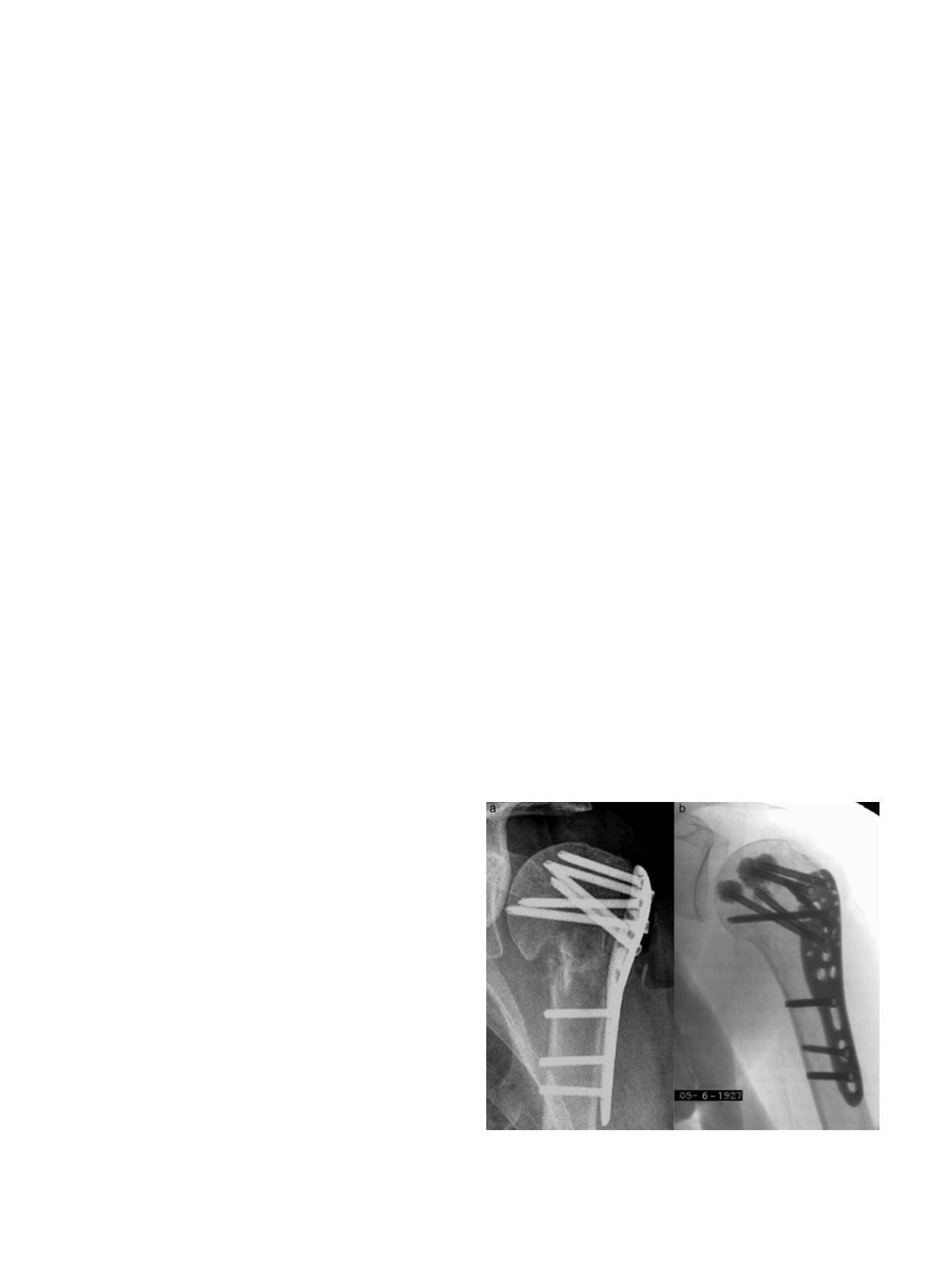

are additional anti rotation screws in dynamic his screw systems, struts
on screws which prevent screw rotation [47] or supporting plates
for femoral neck pins (Figure 3) [48]. Finally, in certain situations
the augmentation of screws with bone cement is very effective in
distributing the load from the metallic implant to the bone ([49,50]).
Correct alignment and accurate fracture reposition
Correct load transfer through the fracture and the adjacent joints is
an essential prerequisite for uneventful fracture healing and complete
restoration of physiological function after fracture. The first and
most important step in fracture fixation is thus the correct alignment
of the load axes followed by reposition of the fracture fragments.
Particularly with pre-contoured anatomical locked plates which do not
have angle variability of the locking screws, correct alignment may
sometimes be difficult to achieve. In these situations the correct
placement of the first screws in the joint block is paramount. In the
shaft area, temporary conventional screws may assist fragment
alignment by pulling the fragments towards the plate. Depending on
the fixation principle, the conventional screw should be removed or
replaced by a locking screw in order to avoid a stress rising effect at the
plate. Compression techniques available in extra-medullary and intra-
medullary implants allow effective fracture reposition but may be
technically demanding [51
–
53]. The compression provides increased
primary and secondary stability by load sharing between implant and
bone [54]. Finally, bone transplants (autologous spongiosa) or bone
cements support restoration of joint surfaces and enable their correct
alignment [55].
Adequate mechanical environment
In fractures involving the shaft, the principle of elastic fixation
which stimulates periosteal callus formation by interfragmentary
movement (secondary healing response) should be employed [56].
Locking plate constructs with a long span length and a large distance
between the two screws above and below the fracture are a viable
option in the meta- and diaphyseal area. Typically titanium plates
are preferable to steel plates because they provide more elastic
deformation. In the central diaphysis a long intramedullary nail with
intramedullary reaming and a maximum of locking distally and
proximally should be the primary choice. Only C-type fractures
involving the joints require a maximum of stability achieved by
stable locking plate constructs often in combination with compression
screws. For stable plate constructs which heal by a primary healing
response it is essential to avoid fracture gaps and achieve accurate
fracture reduction and alignment [56].
In the clinical setting, common fragility fractures having increased
risk for complications include fractures of the proximal humerus, distal
radius, proximal femur, and spine [57
–
62].
Fragility fractures of the proximal humerus
Fractures of the proximal humerus are a typical injury of the elderly
patient over 65 years of age, and the majority of these fractures are
related to osteoporosis [63] and to an increased risk of falls. Multiple
studies revealed that osteoporosis, displaced varus fracture, insuffi-
cient restoration of medial calcar support, humeral head ischemia and
insufficient fracture reduction are independent risk factors for
reduction loss after surgery of proximal humerus fractures [64,65].
Therefore, fractures of the proximal humerus remain a problem
difficult to treat. They are often associated with damage to the
rotator cuff leading to decreased shoulder function. Preoperative
assessment of local bone quality may be critical in facilitating decision
making regarding surgical and non-surgical treatment [66]. In many
comminuted three- or four-part fractures there is insufficient bone
quality to achieve a good purchase with internal devices. Therefore,
intramedullary devices have been developed that are located more
medially, have a shorter lever arm than plates, preserve the blood
supply of the periosteum and soft tissues, and are inserted with a
minimally-invasive technique [41]. Their central location provides a
uniform load distribution. However, in unstable or comminuted lateral
metaphyseal fractures, and particularly if the starting point extends
into the greater tuberosity, failure of fixation or fracture displacement
may occur [67]. Also in head-split fractures intramedullary nailing is
not indicated. Due to these concerns and also technical challenges with
proximal humeral nails, anatomically pre-contoured locking compres-
sion plates have been developed, offering the advantage of divergent
locking head-screws which enter the humeral head at various angles in
order to maximize purchase and create an angle stable device [68
–
70].
Additional holes in the plate allow tension-band fixation of the rotator
cuff while the anatomical design of the implant allows easier
application of the plate and minimizes subacromial impingement
[71]. Screwpull-out is significantly linked with decreased bonemineral
density and with the minimal contact interface between implant and
low density bone [72,73].
The large amount of technical proposals for the treatment of
osteoporotic proximal humeral fractures demonstrates the difficulty
associated with these fractures. Technical solutions to improve fracture
fixation in the humerus include fixed and variable angled locking
plates, the use of blades [74], the augmentation with bone cement
(Figure 1) [50], augmentation with intramedullary fibular grafts [75],
or iliac crest bone grafts [76]. Beside the mandatory preoperative
planning including three-dimensional computer tomography scans
[77] other new tools to determine local bone quality within the
humeral head in real time have been developed [77]. Outcome of
hemiarthroplasty is closely related to anatomical tuberosity healing
and restoration of rotator cuff function, and reverse shoulder
arthroplasty may provide satisfactory shoulder function in geriatric
patients, rotator cuff dysfunction or failure of first-line treatment [64].
Fragility fractures of the distal radius
The osteoporotic distal radius is deficient in both cortical and
trabecular bone, but early changes in cortical bone are strongest
predictors for fragility fractures [78]. Therefore, osteoporotic fractures
of the distal radius remain a complex entity to be surgically treated.
With patients living longer and being more active, these fractures
Fig. 1.
Left: Failure of fracture fixation in an osteoporotic proximal humerus fracture.
Inadequate reduction and insufficient calcar support resulting in articular screw per-
foration. Right: Locking plate fixation of an osteoporotic proximal humerus fracture
reinforced by cement augmentation of the screw tips.
C. von Rüden, P. Augat / Injury, Int. J. Care Injured 47S2 (2016) S3
–
S10
S6


















